|
Cultivation Practices-Mauritius
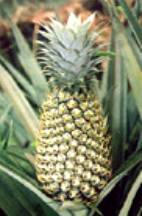 Mauritius is the main
variety cultivated in Kerala. This variety is recommended for cultivation for table
purposes and distant marketing, due to its shorter duration, better fruit quality,
keeping quality and transportability. Mauritius is the main
variety cultivated in Kerala. This variety is recommended for cultivation for table
purposes and distant marketing, due to its shorter duration, better fruit quality,
keeping quality and transportability.
Fruits of Mauritius variety are of medium size and are of two types, deep yellow
and red skinned. Fruits of yellow variety are oblong, fibrous, and medium
sweet compared to red type. The leaves are yellowish green, spiny throughout
the margin, crown also is spiny in both the types. It is a mid-season cultivar,
ripens in July-August.
The cultivation practice of this variety is described hereunder.
Season
Main season of planting is April-May and August-September, but can also be planted
in all months except during heavy rain of June-July. The best time for planting
is August. For getting maximum price and better keeping quality, the best
planting time is April-May. During summer months, if there are no summer showers
after planting, irrigation should be given three weeks after planting for proper
establishment.
Cropping system
Mauritius can be grown as a pure crop in garden land, reclaimed lowlands and wetlands
and as an intercrop in coconut and newly planted rubber plantations. In rubber
plantation, it can be grown for the first 3-4 years only.
Land preparation
Pure crop:
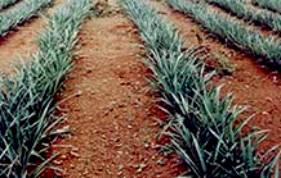 Prepare the land by
digging the area to be planted at 90 cm width in rows / strips, leaving the interspaces
undisturbed. However, ploughing can be adopted in level land. Planting
is done in paired rows of 45 cm distance between rows and 30 cm between suckers.
Suckers may be planted in triangular method in the paired rows. Interspace
between the paired rows is kept at 1.5 m. Contour planting may be adopted
in sloppy areas. Prepare the land by
digging the area to be planted at 90 cm width in rows / strips, leaving the interspaces
undisturbed. However, ploughing can be adopted in level land. Planting
is done in paired rows of 45 cm distance between rows and 30 cm between suckers.
Suckers may be planted in triangular method in the paired rows. Interspace
between the paired rows is kept at 1.5 m. Contour planting may be adopted
in sloppy areas.
Intercropping in coconut garden:
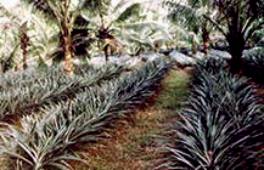
Land preparation, spacing and planting are the same as described above. There
can be three-paired rows in between two rows of coconut.
Intercropping in rubber plantations:
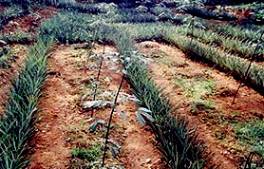
System of planting is in paired rows at 45 x 30 cm. There will be only one
paired row of pineapple in between two rows of rubber.
Wetlands / lowlands:
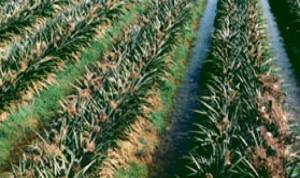 Pineapple
is highly sensitive to water stagnation and high moisture regimes. Hence it
is important to provide good drainage, if grown in wetlands. In paddy lands,
pineapple is planted in paired rows at 45 x 30 cm spacing on ridges taken at 60-90
cm height, depending on the water table and drainage requirement. The ridges
are separated by drainage channels having 60 cm width. The width of the ridges
varies from 1.2-1.5 m. Wherever water stagnation and poor drainage are expected,
a wider and deeper channel is given in between ridges. Pineapple
is highly sensitive to water stagnation and high moisture regimes. Hence it
is important to provide good drainage, if grown in wetlands. In paddy lands,
pineapple is planted in paired rows at 45 x 30 cm spacing on ridges taken at 60-90
cm height, depending on the water table and drainage requirement. The ridges
are separated by drainage channels having 60 cm width. The width of the ridges
varies from 1.2-1.5 m. Wherever water stagnation and poor drainage are expected,
a wider and deeper channel is given in between ridges.
Cowpea, sunhemp or diancha can be sown in the interspaces and covered
with soil soon after planting the suckers.
The biomass can be uprooted at flowering and applied to pineapple plots as manure.
This will also help to control the weeds by smothering them up to four months.
Selection of suckers
Suckers are selected from disease and pest free healthy plants. Suckers are
to be graded into those having 0.5-0.75 kg and 0.75-1 kg. The graded suckers
are planted in different blocks or plots, to get uniformity in growth and flowering.
Bigger suckers give early yield. Dipping of suckers in 1% Bordeaux mixture
and 0.05% quinalphos will protect the suckers against diseases and pests.
Planting
After preliminary land preparations, planting is done in small pits of 10-15 cm
depth at a spacing of 45 cm between rows and 30 cm between plants in the rows.
There is no need to plant the suckers in trenches.
Manuring
Apply compost / FYM at the rate of 25 t/ha at the time of planting. Apply
fertilizers at the rate of 8:4:8 g N: P2O5: K2O
per plant per year. Full dose of P2O5 is applied as
basal at the time of planting. Nitrogen and K2O are applied as
four equal split doses after planting. First dose may be applied at 40-50
days after planting and thereafter at 60-70 days intervals.
Irrigation
Wherever irrigation facilities are available, providing irrigation in summer months
at two weeks intervals results in good fruit size and high yield. If there
is no irrigation facility, the crop should be scheduled for harvest before summer
months (before March).
Weed control
Pre-emergence (within a few weeks after planting) spray of diuron @ 1 kg/ha in 600
litres of water can keep the field free of weeds for about four months. For
subsequent weed control, herbicide application is repeated. For controlling
Mikania micrantha (vayara valli or American valli), spot-application of
diuron can be adopted. Spraying should be done in moist soil, but avoiding
rainy periods. Weeds in interspaces can be controlled by spraying glyphosate
0.8 kg/ha. While spraying in interspaces, care should be taken that the weedicide
shall not fall on pineapple plant.
Flower induction
For inducing uniform flowering, 25 ppm ethephon is applied on physiologically mature
plants having 39-42 leaves (7-8 months after planting). The solution for application
in 1000 plants is prepared by adding 1.25 ml of ethephon (3.2 ml of 39% ethrel or
12.5 ml of 10% ethrel), 1 kg urea and 20 g calcium carbonate to 50 litres of water.
Pour 50 ml of the prepared solution to the heart of the plant during dry weather
conditions (when there is no rain during the time of application).
Flowering starts by 30 days and completes within 40 days of growth regulator application.
Fruits will be ready for harvest by 130-135 days after the application of growth
regulator. Harvest over different months / seasons could be obtained by carefully
phasing / planning the planting and growth regulator application.
Top
|